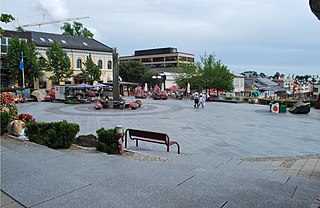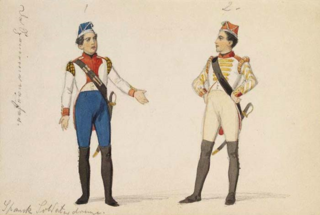This article needs additional citations for verification .(April 2013) |

Pleated Christmas hearts (Danish : Julehjerte) are Danish, Norwegian, and north German crafts, commonly used as Christmas ornaments. [1]
This article needs additional citations for verification .(April 2013) |

Pleated Christmas hearts (Danish : Julehjerte) are Danish, Norwegian, and north German crafts, commonly used as Christmas ornaments. [1]
The exact age and origin of the tradition of making paper hearts is unknown, but the oldest known pleated Christmas hearts were made by the Danish author Hans Christian Andersen in 1860. However, as Andersen's heart has no handle, it seems unlikely it could have been used as a Christmas tree ornament. Andersen's pleated heart is today located in the Hans Christian Andersen Museum in the city of Odense in Denmark. It is documented, however, that Andersen did make decorations for Christmas trees, and that the predecessors of the pleated Christmas hearts were miniature wicker baskets.[ citation needed ]
The oldest known guide to making pleated Christmas hearts is found in an 1871 edition of the Danish journal Nordisk Husflidstidende. [2] The oldest pleated Christmas heart (from 1873) is preserved at the National Museum of Norway, in Oslo. [2] But it was still some 40 years before the pleated Christmas hearts became more widespread.
The oldest depiction of a Christmas tree decorated with pleated hearts dates from 1901 from the Danish manor house Søllestedgaard. [2] That same year, the pleated heart motif was used by Swedish artist Carl Larsson in the lithograph Brita as Idun . [3]
It is believed that Danish kindergartens from around 1910 started spreading the use of the pleated Christmas hearts, which were made from glossy paper in order to enhance the children's creative abilities, patience, and fine motor skills.[ citation needed ]

A Christmas tree is a decorated tree, usually an evergreen conifer, such as a spruce, pine or fir, or an artificial tree of similar appearance, associated with the celebration of Christmas.

Hans Christian Andersen was a Danish author. Although a prolific writer of plays, travelogues, novels, and poems, he is best remembered for his literary fairy tales.

Odense is the third largest city in Denmark and the largest city on the island of Funen. As of 1 January 2024, the city proper had a population of 183,763 while Odense Municipality had a population of 209,078, making it the fourth largest municipality in Denmark. Eurostat and OECD have used a definition for the Metropolitan area of Odense, which includes all municipalities in the Province of Funen, with a total population of 504,066 as of 1 July 2022.

Larvik is a municipality in Vestfold county, Norway. It is located in the traditional district of Vestfold. The administrative centre of the municipality is the city of Larvik. Other main population centres in the municipality include the town of Stavern and the villages of Gjone, Helgeroa, Hem, Kjose, Kvelde, Nevlunghavn, Skinmo, Svarstad, Ula, Verningen, and Tjøllingvollen.

The krone is the official currency of Denmark, Greenland, and the Faroe Islands, introduced on 1 January 1875. Both the ISO code "DKK" and currency sign "kr." are in common use; the former precedes the value, the latter in some contexts follows it. The currency is sometimes referred to as the Danish crown in English, since krone literally means crown. Krone coins have been minted in Denmark since the 17th century.

The culture of Denmark has a rich artistic and scientific heritage. The fairy tales of Hans Christian Andersen (1805–1875), the philosophical essays of Søren Kierkegaard (1813–1855), the short stories of Karen Blixen, penname Isak Dinesen, (1885–1962), the plays of Ludvig Holberg (1684–1754), modern authors such as Herman Bang and Nobel laureate Henrik Pontoppidan and the dense, aphoristic poetry of Piet Hein (1905–1996), have earned international recognition, as have the symphonies of Carl Nielsen (1865–1931). From the mid-1990s, Danish films have attracted international attention, especially those associated with Dogme 95 like those of Lars Von Trier. Denmark has had a strong tradition of movie making and Carl Theodor Dreyer has been recognised as one of the world's greatest film directors. The astronomical discoveries of Tycho Brahe (1546–1601), Ludwig A. Colding's (1815–1888) neglected articulation of the principle of conservation of energy, and the foundational contributions to atomic physics of Niels Bohr (1885–1962); in this century Lene Vestergaard Hau in quantum physics involving the stopping of light, advances in nano-technology, and contributions to the understanding of Bose-Einstein Condensates, demonstrate the range and endurance of Danish scientific achievement.

A tree-topper or treetopper is a decorative ornament placed on the top of a Christmas tree. Tree-toppers come in many forms, though the most common include a star, angel, or fairy. Additional forms range from a paper rosette, ribbon bow, Father Christmas or Santa Claus, to a Christian cross, owl, white dove, spike, or sunburst.

Christmas ornaments, baubles, globes, "Christmas bulbs", or "Christmas bubbles" are decoration items, usually to decorate Christmas trees. These decorations may be woven, blown, molded, carved from wood or expanded polystyrene, or made by other techniques.
Museum Odense is a self-governing museum institution in Odense, Denmark.

The culture of Norway is closely linked to the country's history and geography. The unique Norwegian farm culture, sustained to this day, has resulted not only from scarce resources and a harsh climate but also from ancient property laws. In the 19th century, it brought about a strong romantic nationalistic movement, which is still visible in the Norwegian language and media. In the 19th century, Norwegian culture blossomed as efforts continued to achieve an independent identity in the areas of literature, art and music. This continues today in the performing arts and as a result of government support for exhibitions, cultural projects and artwork.

"The Steadfast Tin Soldier" is a literary fairy tale by Hans Christian Andersen about a tin soldier's love for a paper ballerina. The tale was first published in Copenhagen by C.A. Reitzel on 2 October 1838 in the first booklet of Fairy Tales Told for Children. New Collection. The booklet consists of Andersen's "The Daisy" and "The Wild Swans". The tale was Andersen's first not based upon a folk tale or a literary model. "The Steadfast Tin Soldier" has been adapted to various media including ballet and animated film.

A Christmas decoration is any of several types of ornamentation used at Christmas and the greater Christmas and holiday season. The traditional colors of Christmas are pine green (evergreen), snow white, and heart red. Gold and silver are also prevalent, as are other metallic colours. Typical images on Christmas decorations include Baby Jesus, Mother Mary, angels, Father Christmas, Santa Claus, and the star of Bethlehem. Advent wreaths, nativity scenes, illuminations, and Moravian stars are popular Christmas decorations.

Jul or jol is the term used for the Christmas holiday season in Scandinavia and parts of Scotland. Originally, jul was the name of a month in the old Germanic calendar. The concept of jul as a period of time rather than a specific event prevailed in Scandinavia; in modern times, jul is a period of time stretching from the fourth Sunday before Christmas Eve, December 24, to (traditionally) mid-January at the date of Epiphany with the month of December and Christmas, and the week up to the New Year, as its highlight. The modern English yule and yuletide are cognates with this term.

Danmarks Nationalbank is the central bank of the Kingdom of Denmark. It is a non-eurozone member of the European System of Central Banks (ESCB). Since its establishment in 1818, the objective of the Nationalbank as an independent and credible institution is to issue the Danish currency, the krone, and ensure its stability. The Board of Governors holds full responsibility for the monetary policy.
"The Fir-Tree" is a literary fairy tale by the Danish poet and author Hans Christian Andersen (1805–1875). The tale is about a fir tree so anxious to grow up, so anxious for greater things, that he cannot appreciate living in the moment. The tale was first published 21 December 1844 with "The Snow Queen", in New Fairy Tales. First Volume. Second Collection, in Copenhagen, Denmark, by C.A. Reitzel. One scholar indicates that "The Fir-Tree" was the first of Andersen's fairy tales to express a deep pessimism.

Jul, the Danish Jule and Christmas, is celebrated throughout December starting either at the beginning of Advent or on 1 December with a variety of traditions. Christmas Eve, Juleaften, the main event of Jul, is celebrated on the evening of 24 December, the evening before the two Christmas holidays, 25 and 26 December. Celebrating on the eve before Christmas is also used for most other holidays in Denmark.

For much of its history Norwegian art is usually considered as part of the wider Nordic art of Scandinavia. It has, especially since about 1100 AD, been strongly influenced by wider trends in European art. After World War II, the influence of the United States strengthened substantially. Due to generous art subsidies, contemporary Norwegian art has a high production per capita.

Holsteinborg Castle is a manor house located 12 kilometres (7.5 mi) southeast of Skælskør, Slagelse Municipality, Denmark. It was built in the first half of the 17th century by members of the Trolle family, who gave it the name Trolholm, but has been owned by the Holstein family since 1707. Hans Christian Andersen was a frequent visitor to the estate in the middle of the 19th century. The main building is situated close to the coast, overlooking Holsteinborg Nor, a shallow watered cove which is almost closed off from the Småland Sea and Great Belt by Glænø, Glænø Stenfed and Glænø Østerfed.

The Legend of the Christmas Spider is an Eastern European folktale which explains one possible origin of tinsel on Christmas trees. It is most prevalent in Western Ukraine, where small ornaments in the shape of a spider are traditionally a part of the Christmas decorations.

When the Spaniards Were Here is a romantic, comic play by Hans Christian Andersen. It premiered on the Royal Danish Theatre in Copenhagen on 6 April 1865, just a few days after the celebration of Andersen's 60th birthday.
{{cite web}}: CS1 maint: numeric names: authors list (link)